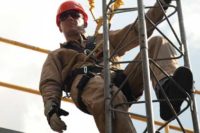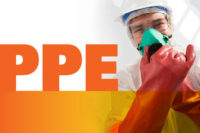Imagine that on the first day at your new job, the foreman tosses you a harness and a 6-foot lanyard and says, “Be careful out there!” That may seem like an extreme example of a woefully inadequate fall protection training program, but I will bet dollars to donuts it happens more often than we think.
This article can serve as a roadmap for employers to identify and close gaps in their fall protection training programs so that any work-at-height can be done safely.
Why is training so important?
Falls continue to be a leading cause of injuries and fatalities in the workplace. In the construction industry, falls account for close to 40 percent of workplace fatalities. Falls are also a leading contributor to injuries and fatalities in general industry, second only to motor vehicle accidents. Many failures can be cited for these high rates: poor housekeeping, inadequate equipment or fall protection systems, failure to consider the hierarchy of fall protection, and many others. A substantial number of these incidents could be prevented with proper comprehensive training.
Training sends a message that safety is a priority, which is not only ethical but also is good for your business because it will make hiring and retention easier and it will reduce risk exposure from fines and litigation.
Who should provide the training?
OSHA 1910.30 is very clear that authorized persons need to receive training from a qualified person. Let’s review what this means.
“Authorized person means a person approved or assigned by the employer to perform a specific type of duty or duties or to be at a specific location or locations at the jobsite.
Qualified describes a person who, by possession of a recognized degree, certificate, or professional standing, or who by extensive knowledge, training, and experience has successfully demonstrated the ability to solve or resolve problems relating to the subject matter, the work, or the project.”
What should be addressed in the training?
It need not be overly complex or theoretical; the training must cover at a minimum the nature of fall hazards in the work area, and how to recognize them. This goes well beyond knowing the height thresholds of 4 feet for general industry and 6 feet for construction. It must address falls onto dangerous or impaling equipment or into hazards that may engulf. There are many myths regarding fall protection, and it would be wise to dispel those as part of the training.
Use hierarchy of fall protection
The training must include procedures to minimize fall hazards. This is where the hierarchy of fall protection takes center stage. Too many employers jump right to active fall arrest or restraint systems before considering if they can engineer out the hazard by performing the work from the ground or bringing the work to the ground. If that is not feasible, the next step would be to use passive fall restraint such as guardrails, parapets, or walls. These measures require very little training and protect a large segment of the workforce while allowing maximum mobility.
If active fall protection must be used, authorized persons must be trained to properly install, inspect, operate, maintain, and disassemble that equipment or system. Additionally, authorized persons must be trained to select the proper system depending on the nature of the fall hazard. If clearance from the work surface to the lower level is not enough to use a 6-foot energy-absorbing lanyard, the user must know that a self-retracting lifeline is needed to ensure they do not contact the lower level. If swing fall is present, especially if it is across an abrasive leading edge, wire rope would be needed instead of a nylon lanyard. The training should address the specific conditions present in the workplace.
Follow the manufacturer’s instructions
Some of us (myself included) consider it a badge of honor to be able to assemble that new desk without referring to the supplied instructions. How hard can it be to figure out that tab A goes into slot D? We may end up with a desk that is unstable, can’t be used as intended and breaks easily. But it’s just a desk! Those same repercussions apply to the human physical body when safety equipment instructions are disregarded.
Typically, the manufacturer’s instructions for use will include “need to know” information such as compatibility of attachments, proper fitting, anchor requirements, inspection, storage, clearance requirements, and much more. This is why it is important for the qualified person to have a listing of all the fall protection equipment and systems used on the jobsite, and to be well versed on the manufacturer’s instruction for use for every item.
Get to know learning styles
Training can be presented in many formats, with or without measurements, but it must be comprehensible by all authorized persons. Training is rarely a “one and done” matter. We all learn through repetition and re-training may be necessary for several reasons.
My experience tells me that the quality and degree of fall protection training from employer to employer spans a wide spectrum. Take the time to evaluate where your training falls on that spectrum. Hopefully, this article can serve as a resource for that evaluation and for taking action to make improvements. Building a culture of safety is not easy, but it will help you recruit and retain employees, and it will protect your business from liability and make it more profitable.
And it is the right thing to do.



